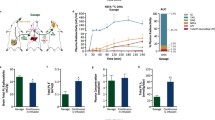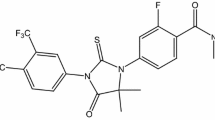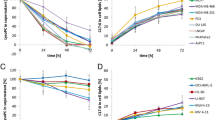Summary
The distribution of the alkylphosphocholine hexadecylphosphocholine (He-PC) and the (alkyl)lysophospholipid 1-0-octadecyl-2-0-methyl-rac-glycero-3-phosphocholine (ET18-OCH3) was analyzed in rats. The compounds were given orally at a daily dose of 75 μmol/kg body weight. After 6, 11, and 18 days, three rats in each treatment group were killed and the drug concentration in various tissues and fluids was determined. With the exception of the kidney (He-PC) and brain (He-PC and ET18-OCH3), steady-state levels of the drugs could be achieved in all organs investigated and in serum. Maximal concentrations of He-PC were found in the kidney, adrenal glands, and spleen, whereas the highest concentrations of ET18-OCH3 were detected in the adrenal glands, spleen, and small intestine. The concentrations of He-PC exceeded those of ET18-OCH3 in most tissues by a factor of about 2–25. Since samples of urine and feces did not contain detectable amounts of the compounds, the absorption of both lipid analogues was assumed to be complete. The total amount of He-PC recovered after 6, 11, and 18 days was 15%, 12%, and 6%, respectively, and that of ET18-OCH3 was 1.3%, 0.8%, and 0.3%, respectively. This indicates that the bioavailability of He-PC and ET18-OCH3 is not controlled by differences in the uptake of the two drugs, but by differences in their metabolism. The results could explain the differing efficacy of these two compounds in their antitumor action in animal models.
Similar content being viewed by others
References
Andreesen R, Osterholz J, Luckenbach A, Costabel U, Schulz A, Speth V, Munder PG, Löhr GW (1984) Tumor cytotoxicity of human macrophages after incubation with synthetic analogues of 2-lysophosphatidylcholine. J Natl Cancer Inst 72:53–58
Berger MR, Munder PG, Schmähl D, Westphal O (1984) Influence of the alkyl-lysophospholipid ET-18-OCH3 on methylnitrosourea-induced rat mammary carcinomas. Oncology 41:109–113
Berger MR, Muschiol C, Schmähl D, Unger C, Eibl H (1987) Chemotherapeutische Studien zur Struktur-Wirkungs-Beziehung zytotoxischer Alkyllysophospholipide an chemisch induzierten Mammakarzinomen der Ratte. In: Unger C, Eibl H, Nagel GA (eds) Die Zellmembran als Angriffspunkt der Tumortherapie. Zuckschwerdt, München, pp 27–36
Breiser A, Kim DJ, Fleer EAM, Damenz W, Drube A, Berger M, Nagel GA, Eibl H, Unger C (1987) Distribution and metabolism of hexadecylphosphocholine in mice. Lipids 22:925–926
Eibl H, Engel J (1992) Synthesis of hexadecylphosphocholine. Prog Exp Tumor Res 34 (in press)
Eibl H, Woolley P (1986) Synthesis of enantiomerically pure glycerolesters and ethers: I. Methods employing the precursor 1,2-isopropylidene-sn-glycerol. Chem Phys Lipids 41:53–63
Fleer EAM, Kim DJ, Unger C, Eibl H (1986) 1-0-Octadecyl-2-0-methyl-rac-glycero-3-phospho-(3H-methyl)-choline: chemical preparation and metabolism in leukemia Raji cells. In: Muccino RR (ed) Proceedings of the Second International Symposium, Kansas City, 3–6 September 1985. Elsevier, Amsterdam, pp 473–478
Fleer EAM, Unger C, Kim DJ, Eibl H (1987) Metabolism of ether phospholipids and analogs in neoplastic cells. Lipids 22:856–861
Fleer EAM, Kim DJ, Nagel GA, Eibl H, Unger C (1990) Cytotoxic activity of lysophosphatidylcholine analogues on human lymphoma Raji cells. Onkologie 13:295–300
Helferman DM, Barnes KC, Kinkade JM, Vogler WR, Shoji M, Kuo JF (1983) Phospholipid-sensitive Ca2+-dependent protein phosphorylation system in various types of leukemic cells from human patients and in human leukemic cell lines HL60 and K562, and its inhibition by alkyl-lysophospholipid. Cancer Res 43: 2955–2961
Herrmann DBJ (1985) Changes in cellular lipid synthesis of normal and neoplastic cells during cytolysis induced by alkyl-lysophospholipid analogues. J Natl Cancer Inst 75:423–430
Herrmann DBJ, Munder PG (1986) Pharmacokinetics of cytotoxic ether phospholipids. Proceedings, 2nd International Conference on PAF and Structurally Related Alkyl Lipids, Gatlinburg, Tennessee, October 26–29, p 156
Herrmann DBG, Besenfelder E, Bicker U, Pahlke W, Böhm E (1987) Pharmacokinetics of the thioether phospholipid analogue BM 41.440 in rats. Lipids 22:952–957
Hilgard P, Stekar J, Voegeli R, Engel J, Schumacher W, Eibl H, Unger C, Berger MR (1988) Characterization of the antitumor activity of hexadecylphosphocholine (D-18 506). Eur J Cancer Clin Oncol 24:1457–1461
Hilgard P, Harlemann JH, Voegeli R, Maurer HR, Echarti C, Unger C (1989) The antineoplastic activity of hexadecylphosphocholine (HPC) is associated with tumor cell differentiation (abstract 2310). Proc Am Assoc Cancer Res 30:580
Hilgard P, Kampherm E, Nolan L, Pohl J, Reissmann T (1992) Investigation into the immunological effects of Milteforsine, a new anticancer agent under development. J Cancer Res Clin Oncol 117 (in press)
Hilgard P, Stekar J, Harlemann H (1992) Experimental therapeutic studies with Miltefosine in rats and mice. Prog Exp Tumor Res 34 (in press)
Hochhuth C, Berkovic D, Eibl H, Unger C, Doenecke D (1990) Effects of antineoplastic phospholipids on parameters of cell differentiation in U 937 cells. J Cancer Res Clin Oncol 116:459–466
Modolell M, Andreesen R, Pahlke W, Brugger U, Munder PG (1979) Disturbance of phospholipid metabolism during the selective destruction of tumor cells induced by alkyl-lysophospholipids. Cancer Res 39:4681–4686
Munder PG, Weltzien HU, Modolell M (1976) Lysolecithin analogs: a new class of immunopotentiators. In: Miescher PA (ed) Proceedings of the 7th International Symposium on Immunopathology. Schwabe, Basel, pp 411–424
Muschiol C, Berger MR, Schuler B, Scherf HR, Garzon FT, Zeller WJ, Unger C, Eibl H, Schmähl D (1987) Alkylphosphocholines: toxicity and anticancer properties. Lipids 22:930–934
Oishi K, Raynor RL, Charp PA, Kuo JF (1988) Regulation of protein kinase C by lysophospholipids. J Biol Chem 263:6865–6871
Rustenbeck J, Lenzen S (1990) Quantitation of a new antineoplastic agent, hexadecylphosphocholine. Arch Pharmacol [Suppl] 341: R111
Schallier DK, Bruyneel EA, Storme GA, Hilgard P, Marcel MM (1990) Hexadecylphosphocholine inhibits invasion of a mouse fibrosarcoma cell line MO4 in vitro (abstract 405). Proc Am Assoc Cancer Res 31:68
Seewald MJ, Olsen RA, Sehgal I, Melder DC, Modest EJ, Powis G (1990) Inhibition of growth factor-dependent inositol phosphate Ca2+ signalling by antitumor ether lipid analogues. Cancer Res 50: 4458–4463
Snyder F, Record M, Smith Z, Blank ML, Hoffmann DR (1987) Mechanistic studies related to their metabolism, subcellular localization, effects on cellular transport systems. In: Unger C, Eibl H, Nagel GA (eds) Die Zellmembran als Angriffspunkt der Tumortherapie. Zuckschwerdt, München, pp 19–26
Storme GA, Bruyneel EA, Schallier DC, Bolscher JG, Berdel WE, Mareel MM (1987) Effects of lipid derivatives on invasion in vitro and on surface glycoproteins of three rodent cell types. Lipids 22: 847–850
Touchstone JC, Levin SS, Dohins MF, Carter PJ (1981) Differentiation of saturated and unsaturated phospholipids on thin layer chromatograms. J High Resol Chromatogr Commun 4:423–426
Unger C, Fleer EAM, Damenz W, Hilgard P, Nagel G, Eibl H (1991) Hexadecylphosphocholine: determination of serum concentrations in rats. J Lipid Mediators 3:71–78
Venditti JM (1981) Preclinical drug development: rationale and methods. Semin Oncol 8:349–361
Zheng B, Oiski K, Shoja M, Eibl H, Berdel WE, Hajdu J, Vogler WR, Kuo JF (1990) Inhibition of protein kinase C (sodium plus potassium)-activated adenosine triphosphatase, and sodium pump by synthetic phospholipid analogues. Cancer Res 50:3025–3031
Author information
Authors and Affiliations
Rights and permissions
About this article
Cite this article
Marschner, N., Kötting, J., Eibl, H. et al. Distribution of hexadecylphosphocholine and octadecyl-methyl-glycero-3-phosphocholine in rat tissues during steady-state treatment. Cancer Chemother. Pharmacol. 31, 18–22 (1992). https://doi.org/10.1007/BF00695989
Received:
Accepted:
Issue Date:
DOI: https://doi.org/10.1007/BF00695989




